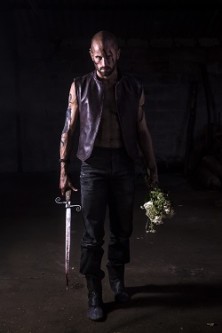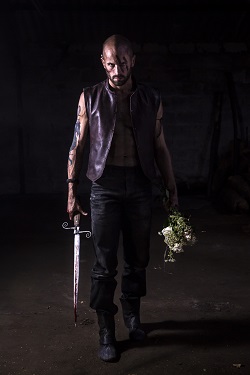 United Kingdom Various composers, The Odyssey: Mark Bruce Company, Wilton’s Music Hall, London, 25.2.2016. (J.O’D)
United Kingdom Various composers, The Odyssey: Mark Bruce Company, Wilton’s Music Hall, London, 25.2.2016. (J.O’D)

Cast:
Odysseus : Christopher Tandy
Penelope: Hannah Kidd
Immortal Man: Christopher Akrill
Immortal Woman: Eleanor Duval
Telemachus: Wayne Parsons
Mortal Woman: Nicole Guarino
Mortal Man: Jordi Calpe Serrats
Calypso: Grace Jabbari
Suitor: Alan Vincent
Scylla: Natalie Dodd
Harpy: Lia Ujčič
Creative & Technical Team:
Choreographer and Director: Mark Bruce
Set Designer: Phil Eddolls
Lighting Designe: Guy Hoare
Costume Designer: Dorothee Brodrück
Puppetry and Masks: Jonny Dixon
Sound Designer: Chris Samuels, Mark Bruce
An auditorium gradually filling with haze; the sound of waves; at the back of the stage a raised, hoop-like structure that will ingeniously reconfigure as Odysseus’ boat; to the left of it a frame studded with light bulbs that resembles a dressing-room mirror. This is what greets the audience before the start of Mark Bruce’s The Odyssey. The haze and the lights seen as pinpoints through it are familiar from Bruce’s Dracula, performed at Wilton’s Music Hall in 2013. So is a set that rises like the façade of a Gothic cathedral.
As the mirror suggests, this is no straightforward retelling of Homer’s epic. The first figure to appear on the stage is ‘Immortal Woman’ (Eleanor Duval). While the piece is yet to begin, she sits down at the mirror as if to apply or check her makeup. After turning to look at the audience, she exits once again. It is ‘Immortal Man’ (Christopher Akrill replacing an injured Jonathan Goddard) who then jumps through the hoop and performs a ‘Please allow me to introduce myself’ dance on the apron stage in front of it.
Only when this dance is finished and the accompanying, hip-swinging chorus in skeleton suits have gone, does Odysseus appear. The story of his twenty-year long return from Troy to Ithaca is always a tale within a tale. The ‘Immortal Woman’ seems to guide or control him through it.
As Odysseus, Christopher Tandy is either miscast, or else Mark Bruce wants the character not to be in the typical ‘hero’ mould (like Glenn Ford and Dana Andrews in 1950s Hollywood). Tandy was perfect as Jonathan Harker in Dracula. His slender frame seems naturally less suited to this part. The very ordinary-looking grey T-shirt he wears under his leather jerkin distances him from it even further.
This uncertainty about the central character (and about who is the central character) may reflect an uncertainty in the work as a whole. Like Dracula, it has an eclectic and ever-changing soundtrack of recorded music (thirty-one pieces are listed) that ranges from Frank Sinatra to Sonic Youth to part of a Mozart mass. For its visual references, The Odyssey also casts its net wide. Calypso wears a nurse’s uniform. The Cyclops is a Father Christmas with an eyepatch. The Sirens are opera singers in bias-cut dresses and ropes of pearls.
The cumulative effect of this is that the whole thing is in danger of passing over you as an impressive spectacle with which it is impossible really to engage. What keeps your attention is the power of some of the images, and the power of some of the performances.
Hannah Kidd, as Penelope, is particularly strong. Wayne Parsons, as Odysseus’ son, Telemachus, has a princely bearing. Jordi Calpe Serrats (‘Mortal Man’) and Eleanor Duval dance a delicate duet in the second half.
The Odyssey depicts a bleak and violent world in which women and men will always be at war; but it is one that contains moments of surprising beauty: the purple cloth held out over the whole stage to represent a sea; a pensive Odysseus making the final stage of his journey on a train suggested by a flashing light beside him and the rhythmic rocking of the chair on which he sits.
John O’Dwyer
